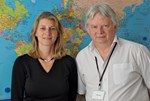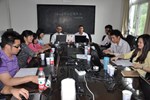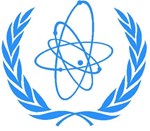An important step forward for the development of the 24 MW electron cyclotron was achieved this past Thursday. During the 13th Management Advisory Committee meeting this week, the ITER Organization concluded its 75th Procurement Arrangement for the Electron Cyclotron High Voltage Power Supplies with the European Domestic Agency.
The high voltage power supply forms the backbone of the electron cyclotron plant, providing up to 90 kV and 50A to each of the twenty-four 1 MW microwave sources. The power supplies provide a high regulation of the applied voltages to actively control delivered power to the plasma based on the plasma requirements. The high regulation is based on the pulse step modulation technique, which essentially stacks several smaller power supplies (or modules) in series. A rapid controller turns each module on and off to provide an accuracy of ±1 percent and modulation frequencies of up to 5kHz.
The European Domestic Agency Fusion for Energy will provide 8 of the 13 power supplies to be delivered to ITER; the remaining 5 power supplies will be procured by the Indian Domestic Agency. If all goes well, the Procurement Arrangement with India will be signed this summer. The first high voltage power supply is scheduled to arrive at the ITER site in late 2015.
The ITER Organization has signed a total of 10 Procurement Arrangements in 2012: eight full Procurement Arrangements and two amendments.
The manufacturing line for the ITER correction coils was inaugurated in Hefei, China on 28 April in the presence of leaders from the Chinese Domestic Agency for ITER (CN-DA), the Anhui Provincial Department of Science and Technology, the Institute of Plasma Physics Chinese Academy of Sciences (ASIPP), experts, and representatives of sub-suppliers. This marks the official launch of correction coil production task.
"The correction coils are part of the ITER magnet system and they will play a key role in ITER's performance," said Luo Delong, vice director of CN-DA. "All of the correction coils will be manufactured and provided by China. No matter how difficult the task is, we must complete it on time, and with high quality. I hope that ASIPP can take advantage of this opportunity to improve the technology and processes in superconducting magnet manufacturing."
Within the vast, 2,300 square-metre facility, the equipment was assembled on time, including the winding line—one of the most important parts of the manufacturing process. The equipment for vacuum pressure impregnation (VPI) had undergone commissioning tests in the presence of ITER Organization representatives that showed that all parameters can meet technical requirements. A laser welding process for correction coil case closure was also selected.
The completion of all commissioning tests will ensure the start of Phase III in the correction coil production task: manufacturing process qualification.
Luo Delong congratulated all those responsible for the completion of the correction coil production line. Wang Min, vice director of the Project & Engineering Department at CN-DA; Li Hongwei, correction coil Technical Responsible Officer; and Li Jiangang, ASIPP director, also took part in the ceremony.
Planning has begun for the complex logistics task of bringing ITER components from factories on three continents to the ITER site in Cadarache. Following the selection of the European company DAHER as Logistics Service Provider (LSP) in February, a two-person DAHER team is now on site to pilot the initial planning phase of the LSP contract.
Laurence Prudhomme, operations manager, and Barry Paul, planning manager, are working closely with the ITER Organization and the Domestic Agencies to collect the many thousands of pieces of information that will allow the DAHER "control room" to plan for—and closely follow—the delivery of ITER components according to the ITER Project's overall schedule.
"The first phase of our mission is fact finding," explains Laurence. "We need to gather detailed information on manufacturing schedules and on the specificities of each load to be transported. We need to look into ship availability, pairing the needs of each load (i.e., heavy lift) with the capacity of each vessel."
Working backwards from the dates the components need to be on site, DAHER will plan all the steps in the transport process—from arranging the specific point of contact where it will take over responsibility for each load, to final delivery. As LSP provider, DAHER is in charge of insurance, customs clearance, interim storage before delivery, handling and unloading on site. During the eighteen months of the planning phase, DAHER will be initiating import customs procedures with the French authorities, and—via its agencies and local partners—export procedures at each manufacturing location.
DAHER IT engineers are currently adapting the company's logistics and industrial flow management tool, DAgeSCOPETM to fit the specificities of the ITER contract. Progressively "filled in" during the planning phase and the future implementation phase, this centralized database will be a powerful tool for optimizing shipments and for orchestrating deliveries according to the progress of ITER assembly.
"Once we have a more detailed schedule of all loads to transport, we'll focus on consolidating shipments wherever possible," says Laurence. "Imagine that we have two loads ready for shipment in Korea and two others nearly ready in Japan. We'll try to organize the shipment of all four loads in the same vessel by coordinating with the different parties."
As part of the initial fact-finding mission, Planning Manager Barry Paul is making a visit to all ITER Domestic Agencies to initiate discussions and conclude individual agreements within the framework of the LSP contract.
The team has one year to prepare for an important deliverable, according to Laurence: "By mid-2013, we will have all the elements we need to provide a comprehensive Transport and Logistics Global Plan (TLGP) to the ITER Organization, containing all the organizational and scheduling details for bringing each ITER component to Cadarache at the requested date."
Since the last Newsline article on the JT-60SA Tokamak construction activities have proceeded in accordance with the Procurement Arrangements between the two implementing agencies: the Japan Atomic Energy Agency (JAEA) and the European Union's Joint Undertaking for ITER and Development of fusion energy (F4E).
Contracts for the 18 toroidal field coils were signed in December 2010. About 4,400 km of niobium-titanium (NbTi) strand have been approved so far by F4E. Two more batches of toroidal field strand (about 600 km of Cu and 650 km of NbTi in total) were delivered before May to the cabling company. Regarding the toroidal field conductor, the first pre-qualification lengths of 20 m and 97 m have been produced, conditioned and delivered for testing or transformation into samples.
The poloidal field magnet for JT-60SA is composed of six equilibrium field (EF) coils and the central solenoid (CS). A winding module for EF4 to be located in the lowest part of the machine was delivered to the Naka site in April 2012. For the central solenoid, the sixth niobium-tin (Nb3Sn) conductor length (466 m) was manufactured for the first module (CS1); the conductors are now all ready.
After the delivery of the first inboard and outboard segments of the vacuum vessel to the site in Naka, welding of the first 40° sector segments was completed in May 2011 in the vacuum vessel sector assembly building. Following the fabrication of the second 40° sector, the fabrication of the third 40° sector was completed in March 2012.
The manufacture of the cryostat base, which will support the weight of the core components such as superconducting magnets and vacuum vessel, is progressing on schedule. The first lower sector has been assembled and welded within tolerances, and is now in the company´s workshop for machining. The cryostat base will be the first large component to be delivered from Europe to Japan in December 2012.
Disassembly of the JT-60 Tokamak must be completed prior to the delivery of the cryostat base. Removal of the 90-tonne coils made very steady progress, and was completed in March 2012. The 18 coils were reassembled in the form of a torus in the storage building at the Naka site, and will stand as a monument to JT-60 success for future generations.
On 24 April 2012, on the occasion of the 10th meeting of the Broader Approach Steering Committee at the Naka site, representatives of Europe and Japan approved a revised baseline schedule, in line with realistic production schedules and with the first plasma in March 2019. The JT-60SA Research Plan, developed with the cooperation of more than 330 researchers from the European and the Japanese fusion research communities, is in place to ensure a successful joint exploitation of JT-60SA, in support of the operation of ITER and preparations for DEMO.
For more information and latest news, please visit our website.
|
Ranjay Sharan has a lot on his shoulders these days. A chief project engineer at the Nuclear Power Corporation of India Ltd (NPCIL), he is a key player in bringing his country's nuclear plant capacity from a present 4780 MW to a projected 63 000 MW in the next 20 years.
And as the newly appointed chairman of the Management Advisory Committee (MAC), he presides over an assembly of experts and delegates whose mission is to provide recommendations to the ITER Council.
While chairing MAC is not a full-time occupation, Ranjay still has to fit two jobs into every work day. "I complete my office job at NPCIL at around 7:00 p.m., go home and have dinner, rest for a moment, and then go to work for ITER for some three to four hours," he says. "I don't need to sleep more than five hours."
A fission engineer who has participated in some of the largest nuclear projects in India, Ranjay was one the first MAC members. "Since the first MAC meeting in May 2007," he says, "I've seen all the ups and downs of the project ..."
Ranjay brings to ITER his expertise in project management. In 2004 he was awarded the Indian Nuclear Society medal by the Hon'ble Prime Minister of India for his management effort in the construction of reactors 3 and 4 of the Tarapur Atomic Power Station, presently the largest nuclear plant in the country. Works were completed eight months ahead of schedule and with a 15 percent cost saving.
The secret for such an achievement? "When you control the schedule," he explains, "you control the cost. And the best schedule is the one you build from scratch with all latest rational and realistic inputs, not the one that is only based on past experience. That's when you can really save time. You also have to be very careful about interface management — whether it's between components or between Members ..."
Can this approach be extrapolated to ITER? "When you build a power plant, the processes and cost-control policies are centralized. At ITER, they are distributed among seven Members, a fact that makes a huge difference. A project such as ITER requires special management practices based on broad cooperation. But cooperation is not enough: each Member has to also be aware of the difficulties that another Member can encounter. This is why I intend to develop bilateral and trilateral cooperation."
The new MAC chair is aware of how different cultures often lead to different approaches, and of how these approaches are sometimes difficult to reconcile. "The ITER Members are sovereign and we have to give due respect to their culture and experience," he says. "But at the same time we must make them converge in order to take the necessary decisions."
One of the greatest challenges to monitoring the production of the large and complex components at the heart of the ITER magnet system is the quick and efficient exchange of quality assurance/quality control (QA/QC) documents and data—important information that needs to be reviewed during the manufacturing process and cleared for acceptance by the responsible Domestic Agency and the ITER Organization.
Following the successful implementation of the Conductor Database tool that tracked production data for the ITER conductors at six Domestic Agencies and their suppliers right through to final acceptance tests, it was decided to develop and implement a Magnet Manufacturing Database (MMD) on the same model.
The Magnet Manufacturing Database will be the main tool for monitoring the QA/QC processes of the Procurement Arrangements for magnet coils, magnet structures and magnet feeders. This web-based application, integrated into ITER's collaborative platform ICP, provides data and process integration with unified access and workflow. For the manufacturers, it offers an inventory control system with the possibility of integrating test result data and acceptance criteria functionalities, and of automatically generating barcodes and lot/serial numbers to facilitate tracking.
For the ITER Organization, the workflow management system included in the database matches the control points defined in each Procurement Arrangement and the manufacturing processes defined in the Manufacturing Inspection Plan. References to ITER documents are included for procedures, instructions, and specifications ... allowing the ITER Organization to identify and manage critical operations such as welding.
The Magnet Manufacturing Database can manage any kind of complex manufacturing process chain, regardless of product type. Real-time production status and work-in progress monitoring will be also developed in a near future, using the IT online reporting system to extract and display data from the database in an efficient manner.
The success of such a tool will rely on the ability of its users around the world to input data in a timely manner. After a prototype implementation at the European Domestic Agency for the toroidal field coil winding packs, representatives of the ITER Magnet Division were in China mid-May to provide extensive training to the staff of the Chinese Domestic Agency, its supplier ASIPP, and some of the ASIPP sub-suppliers to launch the Magnet Manufacturing Database for the feeders, high temperature superconductor leads, and correction coils.
The sun was at its hottest this Friday at 12:30 p.m. when close to 500 ITER employees gathered for China Day—the first of a series of ITER Member Days that celebrate the unique, multicultural work environment of ITER and offer ITER employees the occasion to discover each other's cultures and traditional foods.
A variety of tasty Chinese foods, traditional music, and colourful decoration gave the event a distinctive Chinese flavour and created the perfect opportunity for employees to share some time together and catch up.
With the construction of ITER, the worldwide magnetic fusion program has begun a transition from a fusion science activity to one aimed at producing fusion energy on an industrial, power plant scale. This is driving an increased emphasis on a fusion technology program which, along with ITER and accompanying research, will bring fusion as a power source within our reach. While internationally there is no agreement on a single roadmap to fusion, the science and technology issues to be resolved for fusion power to become a reality are broadly agreed.
Resolving these issues and understanding the options for next-step fusion nuclear facilities are of common interest, even if the emphases and priorities vary from nation to nation. Thus there is substantial scope to add value to the program by international cooperation. Against this backdrop, the International Atomic Energy Agency (IAEA) has established a series of annual DEMO Programme Workshops to facilitate international collaboration on defining and coordinating DEMO program activities. The first IAEA DEMO Programme Workshop (DPW-2012) will be held at the University of California at Los Angeles (UCLA), Los Angeles, California, United States of America from 15 to 18 October 2012. The meeting will be hosted by the University of California at Los Angeles.
The specific objective of this first workshop is to discuss a subset of key DEMO scientific and technical issues with the aim of defining the facilities and program activities that can lead to their resolution. The topics include fusion power extraction and tritium fuel cycle, plasma power exhaust and impurity control, magnetic configuration and operating scenario for a next-step fusion nuclear facility. The workshop output will be information that could be used by any party as input to the planning of possible roadmaps to DEMO. For more information on the workshop please click here.
|










